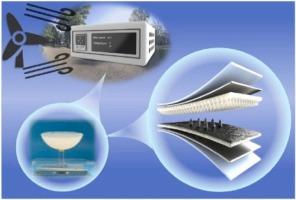超高灵敏度摩擦电压力传感器的双纳米/微尖端阵列液固界面
IF 17.1
1区 材料科学
Q1 CHEMISTRY, PHYSICAL
引用次数: 0
摘要
特定的液固接触电气化展示了一个独特的和有前途的一代压力传感器。然而,提高液固界面的灵敏度仍然是一个重大挑战。在这项工作中,我们提出了一种基于流体和固相之间应变集中双尖端阵列设计的铁磁流体摩擦电压力传感器(FTPS)。采用具有锥形微纳结构阵列的硅橡胶薄膜和具有尖锐尖峰微结构的铁磁流体作为摩擦电对。固体和液体传感层的阵列状微结构呈现相反的排列,表现为双尖端阵列结构。应变集中效应是由固体尖端组织的高疏水性和液体尖端组织的高锐性耦合产生的。在承重结构中,当形状发生突然变化时,应变会显著增加。在单位压力下,接触面处的垂直变形与FTPS的灵敏度呈正相关。因此,获得了前所未有的38.84 kPa−1的高灵敏度和难以想象的0.76 Pa的低检测限。最后,展示了基于FTPS的高灵敏度、高稳定性的风速和风向检测,在环境监测和气象预报中具有广泛的实际应用价值。本文章由计算机程序翻译,如有差异,请以英文原文为准。

Dual nano/micro tip-array based liquid–solid interface for ultrahigh sensitive triboelectric pressure sensors
Specific liquid![]() solid contact electrification demonstrates a unique and promising generation of pressure sensors. However, improving sensitivity at the liquid
solid contact electrification demonstrates a unique and promising generation of pressure sensors. However, improving sensitivity at the liquid![]() solid interface remains a substantial challenge. In this work, we present a ferrofluid-based triboelectric pressure sensor (FTPS) based on a strain-concentrated dual tip-array design between the liquid and solid phases. A silicone rubber film with a conical micro/nanostructure array and a ferrofluid with incisive spike microstructures tuned by a solid baseplate are employed as triboelectric pairs. The array-shaped microstructures of the solid- and liquid-sensing layers exhibit an opposing arrangement, manifesting a dual tip-array structure. The strain concentration effect arises from the coupling of high hydrophobicity caused by solid tip microstructures and high sharpness of liquid tip microstructures. In a load-bearing structure, there is a significant increase in strain when a sudden change in shape occurs. The sensitivity of the FTPS is positively correlated with the vertical deformation at the interface per unit pressure. Thus, an unprecedentedly high sensitivity of 38.84 kPa−1 and an inconceivably low detection limit of 0.76 Pa are attained. Finally, wind speed and direction detection with high sensitivity and stability based on the FTPS is demonstrated, indicating extensive practical applications for environmental monitoring and meteorological forecasting.
solid interface remains a substantial challenge. In this work, we present a ferrofluid-based triboelectric pressure sensor (FTPS) based on a strain-concentrated dual tip-array design between the liquid and solid phases. A silicone rubber film with a conical micro/nanostructure array and a ferrofluid with incisive spike microstructures tuned by a solid baseplate are employed as triboelectric pairs. The array-shaped microstructures of the solid- and liquid-sensing layers exhibit an opposing arrangement, manifesting a dual tip-array structure. The strain concentration effect arises from the coupling of high hydrophobicity caused by solid tip microstructures and high sharpness of liquid tip microstructures. In a load-bearing structure, there is a significant increase in strain when a sudden change in shape occurs. The sensitivity of the FTPS is positively correlated with the vertical deformation at the interface per unit pressure. Thus, an unprecedentedly high sensitivity of 38.84 kPa−1 and an inconceivably low detection limit of 0.76 Pa are attained. Finally, wind speed and direction detection with high sensitivity and stability based on the FTPS is demonstrated, indicating extensive practical applications for environmental monitoring and meteorological forecasting.
求助全文
通过发布文献求助,成功后即可免费获取论文全文。
去求助
来源期刊

Nano Energy
CHEMISTRY, PHYSICAL-NANOSCIENCE & NANOTECHNOLOGY
CiteScore
30.30
自引率
7.40%
发文量
1207
审稿时长
23 days
期刊介绍:
Nano Energy is a multidisciplinary, rapid-publication forum of original peer-reviewed contributions on the science and engineering of nanomaterials and nanodevices used in all forms of energy harvesting, conversion, storage, utilization and policy. Through its mixture of articles, reviews, communications, research news, and information on key developments, Nano Energy provides a comprehensive coverage of this exciting and dynamic field which joins nanoscience and nanotechnology with energy science. The journal is relevant to all those who are interested in nanomaterials solutions to the energy problem.
Nano Energy publishes original experimental and theoretical research on all aspects of energy-related research which utilizes nanomaterials and nanotechnology. Manuscripts of four types are considered: review articles which inform readers of the latest research and advances in energy science; rapid communications which feature exciting research breakthroughs in the field; full-length articles which report comprehensive research developments; and news and opinions which comment on topical issues or express views on the developments in related fields.
 求助内容:
求助内容: 应助结果提醒方式:
应助结果提醒方式:


